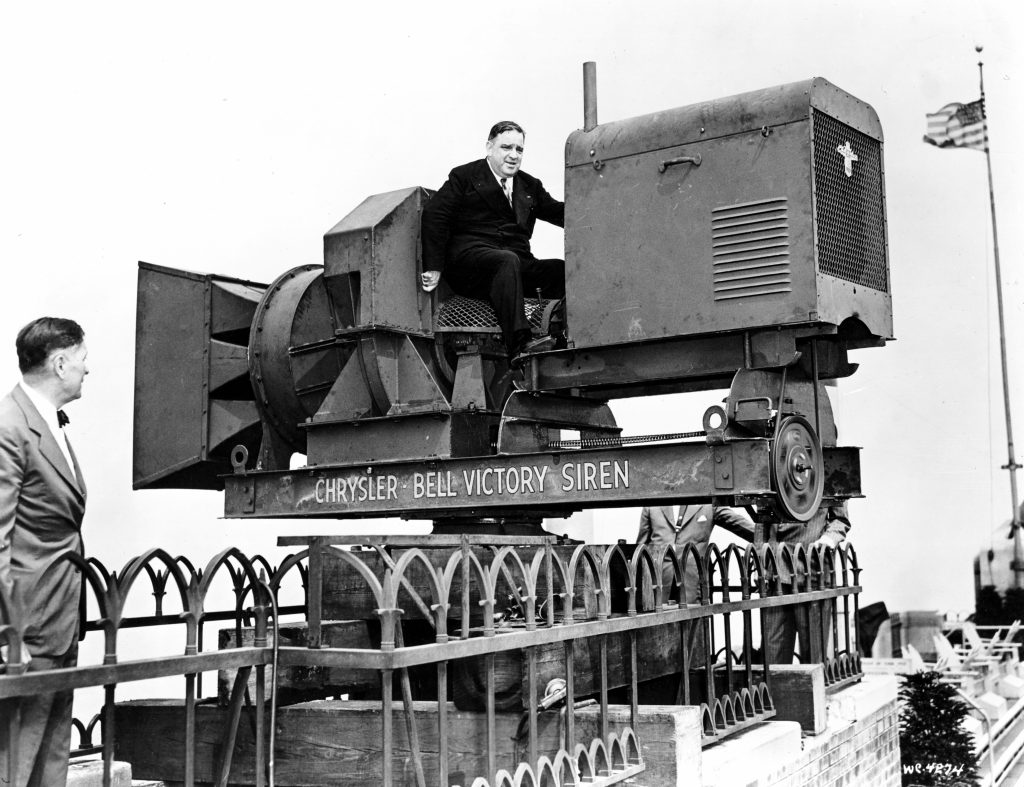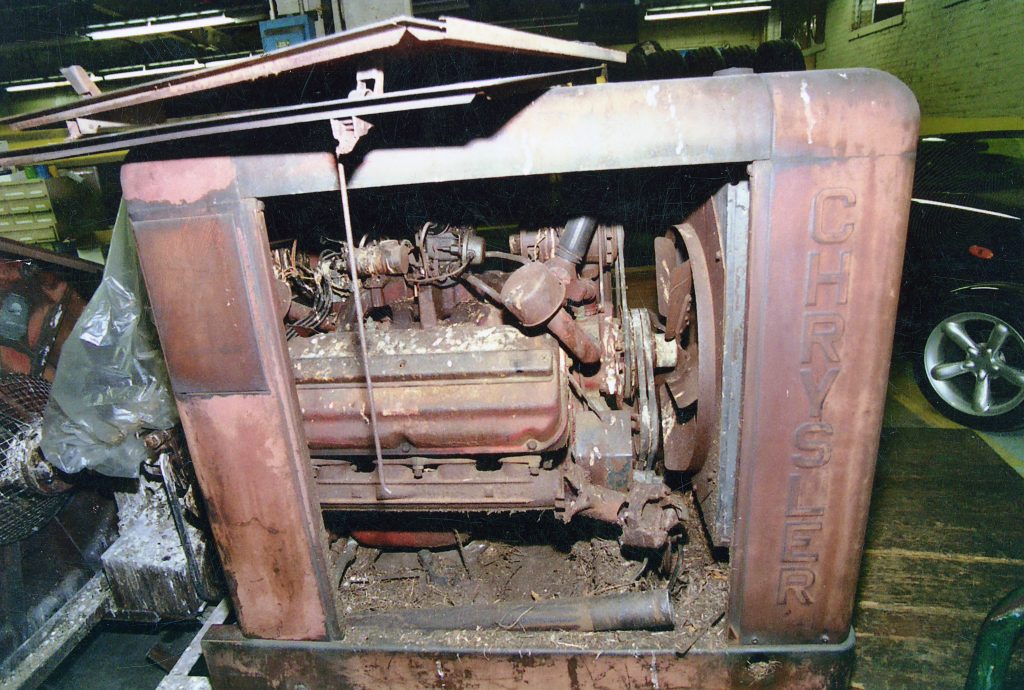Tommy Can You Hear Me?
The Chrysler-powered air raid siren was the loudest man-made object in 1956. Yeah, even louder than your wife.

The Walter P. Chrysler Museum-restored air raid siren is powered by a 1956 180 horsepower Chrysler Industrial 331 cubic inch Hemi. A super duty 3-stage compressor blows 2,610 cubic feet of air per minute at nearly 7 PSI. The air leaves the six horns at a velocity of 400 miles per hour. The result is an incredibly loud 138-189 dB. The siren is almost 12 feet long and weighs 4 tons. The resulting sound is intended to be heard 4 miles away and it has been reported that it has been heard at a distance of over 20 miles. The engine was equipped with a remote starter, engine and battery warmers and a trickle charger for the battery.
Back a few years, Ma Mopar ran a neat promo centered around their 426 Hemi engine. They built and trotted around to shows some really cute creations, such as a Hemi-powered carousel, Big Wheel, barbecue grill, snow blowerâŠeverything short of a Hemi-powered Water Pik (clean between your teeth and demolish buildings). But, in truth, they all pale when compared to the application of the Hemi (first generation) in 1952. Unlike the made-for fun 426 Hemi models, The 331-cube Hemi was applied to a serious piece of hardware. A loud piece of hardware. An air raid siren.
The concept of a loud siren was developed by Bell Labs, back during World War II. The thought was to use it as a means to confuse or deafen the enemy, as if bombs and artillery shells werenât confusing and deafening enough. Back then, the Chrysler 8-cylinder Hemi hadnât been invented yet, so the companyâs venerable flathead Six was hooked up to Bellâs siren. We donât know if the siren actually was employed for its original purpose (the military probably figured that bullets were more effective), but hundreds were made and installed in cities across America as Civil Defense air raid sirens.

Cold War-era sirens being assembled from 1952-â57 at Chryslerâs Trenton Engine Plant. The siren section was produced by Bell Labs. The American Blower Corp. supplied the parts for the compressor and Chrysler machined it. The siren produced 189 dB at the throat, and 138 dB at 100 ft. from throat. It cost $5,500.
Thankfully, the sirens were never spun in anger (though they were periodically tested, broadcasting Chrysler power far and wide). While some say that the sirenâs sole purpose was to warn of an impending enemy aircraft attack, itâs conceivable that some could have been used for fire and tornado warning after the war had ended. . But while the hot war had cooled, the Cold War was heating up. Now, with the threat of a missile attack, Chrysler was back in the air raid siren business.
This is the siren in as-received condition by the museum from the city of Trenton in 2003 All together, there were three separate models of the Bell Labs-designed/Chrysler-built sirens from 1942 through 1957. The last (Cold War) model was the loudest. The Chrysler Air Raid Siren featured here, was produced at the Chrysler Trenton Engine Plant in 1956. This last series was built from 1952 until 1957 when production of all sirens stopped. Several hundred of these versions were built, and installed and used in many major American cities during the 1950s and 1960s including Los Angeles, New York, Detroit and Chicago. A couple of these sirens have been found by collectors (yes, there are folks that collect air raid sirens) as far away as Australia and China.


Chryslerâs flathead Six was used to power the sirens used during WW II.
The guy in the âdriverâs seatâ looks a bit nervous. Check out his right hand holding on for dear life. Civil Defense team uses high-tech equipment to check for enemy planes. Note CD patch on the right arms.
This siren was purchased by the City of Trenton Michigan in 1958. It served the community at the Trenton Fire Departmentâs station on King Road until the late 1970s. In 2003, the Walter P. Chrysler Museum received a call from the Trenton fire Department. They had this âthingâ that hadnât been used in years, sitting on the top of a tower which they wanted to tear down. The Museum could have the siren, if they footed the bill to demolish the tower. A deal was finally struck where the Museum and the fire department would split the cost.
The museum had their chief mechanic to climb the tower and check out the siren. It was pretty gross, what with the pigeons and squirrels having made the siren a thriving retirement community. A crane removed the 12-foot long, 3-ton siren from the tower. It was transported to the museumâs shop, where the Hemi was completely gone through. The Chrysler folks decided not to get into the siren section as it still functioned just fine. It was treated to just a cosmetic restoration.
In September 2006, the siren was installed as a museum exhibit. It was also trucked around on a flatbed to various outings. The restored sirenâs first showing was at the Trenton Fire Department, in a celebration attended by the mayor, police chief and fire chief. âCourse, everyone wanted to hear the siren. The Museum guys fired up the Hemi, and banged in the direct drive (no clutch) siren and throttled the revs from idle to low power and back to idle. The mayor came up to the engine man. âHey, is that the best you can do?â
Oookaay
This time the revs went further up the scale, but not to the full power of 138 dBâa sound louder than standing next to the exhaust of a jet engine. Louder than any steam whistle or horn ever made, the siren was said to be the loudest man-made object ever produced in â56. At full song, the wail would have certainly âconfused or deafenedâ the local Trentonites. The Chrysler literature of the time said that immediate ear damage would be caused to all unprotected ears. It is also said that the siren could dissipate clouds, turn fog into


This is the siren in as-received condition by the museum from the city of Trenton in 2003
 Even at partial power during the Trenton demonstration, with the siren aimed down in the direction of a highway, oncoming traffic 1/2-mile away came to a complete stop, with some cars actually starting to back up! This time, the mayor didnât complain.
You can see and hear run-ups of the siren by the W. P. Chrysler Museum folks on YouTube: http://www.youtube.com/watch?v=GCL4fetXQkg

